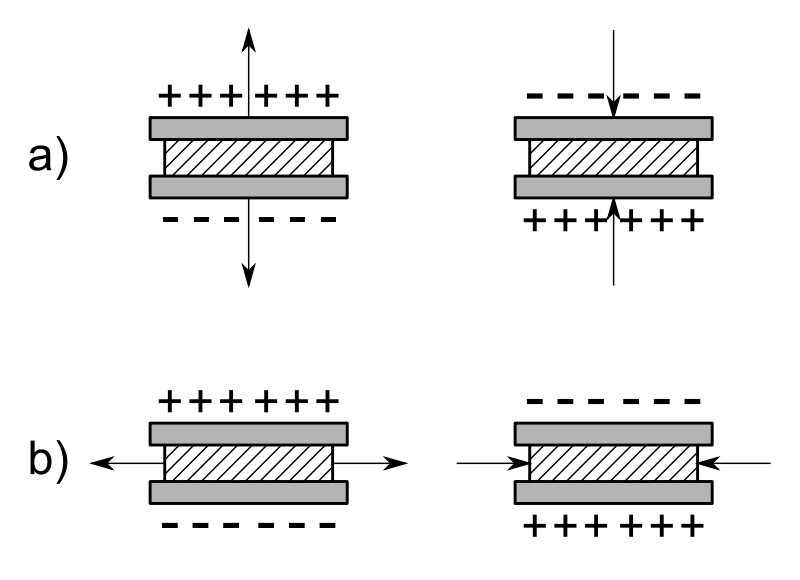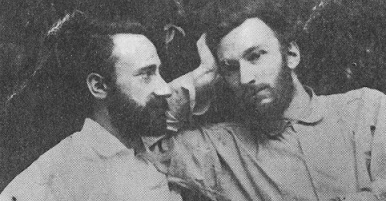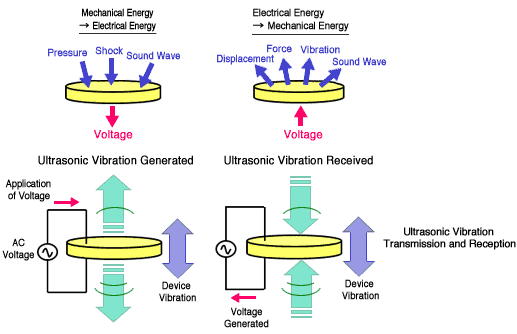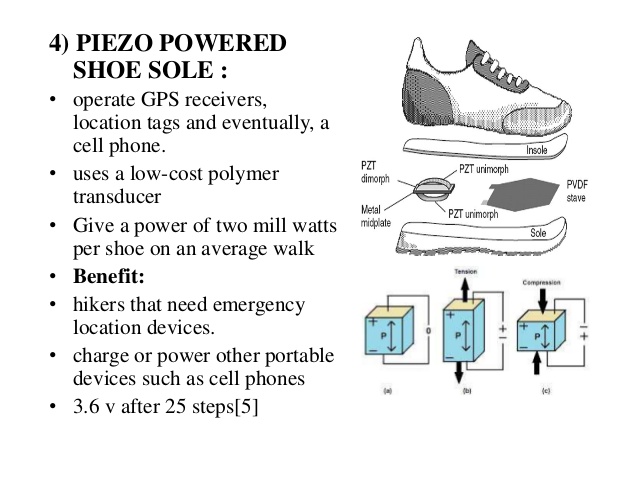The Energy Squeeze
A lead zirconate titanate crystal (PZT), one of the most common piezoelectric crystals in use today. Stretching the crystal generates an electric charge. Source - Wikipedia, Pinin
If a crystal is placed between two metal plates and stretched (a) it produces a dipole. If it is squashed (b) it produces the opposite dipole. Source - Wikimedia, CLI
The idea that you can generate electrical energy by squeezing a crystal sounds almost paranormal, but its true. A crystalline structure is in perfect electromagnetic balance. The distance between the atoms is exactly right. But if we change the distance between the atoms in a crystal by pulling them apart of forcing them closer together, it creates an electromagnetic imbalance that is expressed as a dipole. A dipole is a pair of opposite charges separated by a distance. Think of a magnet with a north and a south pole.
What this basically means is that by squeezing or stretching a crystal you can generate electrical energy. Conversely, if you introduce electrical energy to a crystal it will flex as if it was being squashed or stretched. These two complementary phenomena, called the piezoelectric effect, allow crystals to be used in a wide variety of applications, some of which I will describe below.
Piezo is from the greek word piezein, meaning squeeze or press.
Many of the articles on this website illustrate that knowledge is a journey in which we become progressively less wrong. This article concentrates instead on how we have made use of our knowledge of piezoelectricity, how our implementation has developed and where it will go in the future. Its more about the growth in our understanding of its usefulness.
The Curie brother, Jacque (left) and Pierre (right). Pierre and his wife Marie won the nobel prize for physics in 1903. Source - Wikimedia, author unknown (circa 1878)
How was the effect discovered?
The Curie brothers, Jacque and Pierre, published their discovery of the connection between electric phenomena and crystal structures in 1880. They measured surface electrical charges appearing on a variety of crystals when they were subjected to mechanical distortion. This included tourmaline, topaz, quartz, cane sugar and Rochelle salt.
What makes this story interesting from the perspective of how we discover things, is the thinking that preceded the discovery.
It was already known that certain substances exhibited electric properties. Friction generated static electricity or contact electricity has been known about for millennia. The Greek philosopher, Thales noted the effect when rubbing amber around 600 BC but it was not until the 17th century that the first friction generator was developed. Pyroelectricity is electrical charge generated by heating crystals. Again this was observed by another Greek philosopher, Theophrastus, around 300 BC and not taken up again until the 17 century.
Gabriel Lippmann, who discovered that the Curie brothers discovery of piezoelectricity was reversible. Source - Wikimedia, Popular Science Monthly Volume 74, unknown author, 1909
The Curie brothers asserted that the three types of phenomena; piezo, contact and pyro electricity were intimately related and used that perception to choose which crystals would produce the best results, even deciding on the best way to cut them. This is a great example of how deductive reasoning can productively precede experiment by suggesting the need for an experiment in the first place and informing the best way to set it up.
The brothers did not however discover that the same principle worked in reverse. This was done by Gabriel Lippmann. Again this was deduced from the mathematical study of the principles of thermodynamics. This was only a year after the Curie brother’s published their paper, and they immediately confirmed Lippmann’s hypothesis by experiment.
By 1882 our understanding of piezoelectricity was well established by experiment. an important discovery was that only a certain type of crystal with an asymmetric structure exhibited the piezoelectric effect.
Most crystal have a symmetric structure. In other words if you turn or flip the crystal structure the arrangement of atoms repeats itself. Asymmetric crystals look different when they are turned or flipped. I have not been able to find out why only asymmetric crystals are piezoelectric. Comment below if you know.
In the following years to 1910 all of the 20 main piezoelectric crystals were identified and ranked for the strength of the effect. Since then many more have been found and synthetically produced specifically for their piezoelectric capabilities.
What did we do with it?
In the period up to the first world war (1914-18) not much was done with piezoelectricity. It was treated more like a curiosity against the more notable advances in electromagnetism generally, which was seeing knowledge turn into wide ranging technological progress.
This graphic shows the different stimuli that can produce voltage from a crystal (top left) and the different effects that result from the crystal’s stimulation by an electric current (top right). Source - Seebo Blog, Yarden Hod. Credit, nec-tokin
The first use of the effect was for submarine detection. and was in use by 1917. It was developed by the French physicist, Paul Langevin. What made the device unusual was that the piezoelectric effect was used for both the emission of a signal and the detection of the returning signal. In other words both versions of the effect were employed. A mica crystal subjected to an electric current produced the emitted signal, and a quartz crystal flexed on receiving the return signal. This created the electric charge that produced the famous ‘ping’ of what eventually became known as Sonar. The success of sonar was the catalyst for a sharp increase in interest and the development of many new applications.
From early on after the first and before the second world wars devices were developed using piezoelectric crystals. When subjected to an electric field these crystals can be made to oscillate at a specific frequency. This gave rise to many applications where it was important for frequencies to be stabilised. Examples are the vacuum tubes used in early radios and TV sets, radio transmitters and of course the quartz wrist watch.
They were also used in devices that probed materials and systems that were otherwise impenetrable like the behaviour of liquids and gasses, structural flaws in metals, vibrations and impacts in engines or studying the initiation of explosive events. For these their ability to produce ultrasonic sound and measure small changes in pressure was crucial.
What is the Piezo Effect, how does it work? What are the applications in motion control? Posted by Nanopositioning
Many of the electronic devices we still use today were originally developed using natural crystals before World War 2. This includes microphones and actuators that depend on the ability of these crystals to flex. The modern version of the microphone is so small and unobtrusive because today we use manufactured crystals that are capable of miniaturisation as well as being massively more efficient and accurate than natural crystals. The video left shows the modern version of actuators and showcases the extraordinary things we can now do with flexing crystals. Check out the tiny walking crystals near the end.
What about the future?
All the development of the piezoelectric effect so far has been to provide us with a utility that is desirable enough to settle for putting in more energy than we get out. By utility I mean something we want to do enough to pay for it with a net expenditure of energy. A couple of obvious examples beyond the exploitation of asymmetric crystals are the internal combustion engine to get more easily from A to B, and heating appliances to keep warm. The law of conservation of energy ensures that we can never get more out than we put in, but reality ensures that, worse still, we get far less than we would like. The efficiency of the internal combustion engine is only 30% for petrol and 45% for diesel. So maybe its not surprising that piezoelectricity is any different.
Piezoelectric mats to recover energy from transport. Source - Innowattech
But what if the energy used to get crystals working for us was energy that we would be expending anyway for other purposes, like driving a car or running to stay healthy? If we could tap into energy expenditure already taking place there would be no net increase in energy use.
Piezoelectric shoes. Source - Slideshare, Mayur Mohurle
This is the idea behind some great ideas not all that far away from implementation. An Israeli company called Innowattech has developed piezoelectric mats. The Innowattech Piezo Electric Generator (IPEG) claims that 1 kilometre of road can produce over 500 kilowatts of electricity per hour, and as you can see from the image left, there are also generators for railways and airports. The energy produced can power the streetlights, traffic lights and road signs.
Another idea is piezoelectric wearables that can charge your devices on the move. Left is a proposal for shoes. There are even YouTube video showing how you could make your own. Other ideas include putting the crystals into the tyres of cars and using the energy to power some of the car’s electronics. One device I have come across but can no longer find is something that you strap to your leg above and below the knee to generate power as you walk and especially when you run.
I hope to be around long enough to see these developments come to fruition and I’ll be first in line for the shoes.






